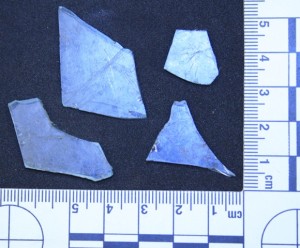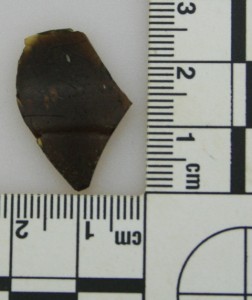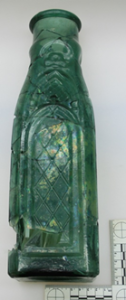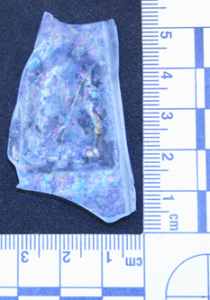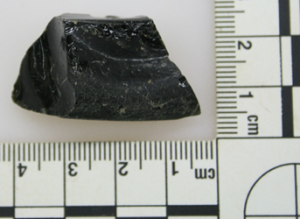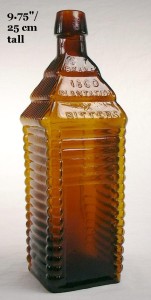While digging in the majority of our units, the most obvious artifacts are typically pieces of glass, both large and small. The sheen of the glass in the sunlight illuminates it and separates it from the rest of the soil. Whether the color of the glass is dark green, amber, light green, or clear when held to the light of the sun, it becomes transparent. Each shard of glass has its own tale to tell us. It is our job to decode each one looking at both the color and design.
Although finding whole or even large fragments of glass is great, it is not usually a common occurrence. Typically we find small to medium shards with little indication of the original form and function. A good example of a typical piece we find is the green glass in the image below.
It is most likely bottle glass, but there are few indicators of where it was located on the bottle (no seam, little curvature, no maker’s mark, etc.). Another example of a common glass fragment we find is window glass, which is identifiable by its flatness, light bluish green color, and medium thickness. The window glass pictured below was found in the northern half of the Block 6 Hospital and is clearly different from the usual bottle glass we also encounter.
Although much of the bottle glass we find is nothing more than fragments, at times it contains hints as to where it fit on the bottle; however, it is still up to us to determine its function. The morphology of a glass bottle is very important in fitting the glass shards we find into the larger puzzle, and can be seen in the image below.
We use this knowledge of the shape and general characteristics of a bottle (neck, finish, base, etc.) as our guide to determining the origin of each glass fragment we find.
A somewhat typical piece of bottle glass found at Johnson’s Island is this amber fragment. They tend to be small, broken pieces that can be difficult to decipher where on the bottle it is from, let alone the specific type of bottle. However, with this artifact we were lucky; there is a small seam running along the outside edge of the glass. When viewing the piece from the side you can see that the areas above and below the seam are curved differently. The smaller area below the seam has a slight curve before flattening out, while the area on top curves in a more rounded way. With how each side is curved, it appears that the more flat area below the seam was part of the body of the bottle, and the more rounded area was leading up to the neck of the bottle.
Based on this, the amber fragment comes from a type of bottle fashioned from a dip mold. The bottom of the bottle was created in a mold and then the top portion was hand blown. It is this seam between the mold and hand blown portion that divides the diagnostic portions of the bottle.
Just as we find glass shards and fragments that we have little to no idea what they came from, we also encounter pieces that are not only easily recognizable, but of the same type as complete bottles housed in the lab. Below are three artifacts side by side with larger examples of what they come from.
This first glass fragment comes from a “Cathedral†Style pickle jar, and was found in the N266 E126 2×2 meter unit by field school student Doug Carter. This style gets its name from the uniquely arched decorations on the pickle jar. The larger green glass jar is also a “Cathedral†Style pickle jar found at Johnson’s Island. Although the fragment does not exactly match that of the larger jar, the style is similar.
Another easily identifiable piece we’ve located is the dark green glass bottle fragment below, characteristic of gin bottles from the era. This artifact, found by Doug Carter in the N264 E126 2×2 meter unit of the Block 8 Latrine, may appear black, but the color is due to the thickness of the glass and its particular chemical make-up. As can be seen in the other picture, the bottle fragment would have been part of a much larger, though just as thick, bottle.
Field school student Corey Chipman found the below light green glass inkwell base fragment in the Block 6 Hospital Mess N218 E136 2×2 meter unit. This piece once belonged to what is referred to as an “Umbrella†style inkwell, one of multiple types of inkwells used during the Civil War. An unbroken inkwell of the same style can be seen in the other image below, also found at the Johnson’s Island Civil War Military Prison.
We love glass because of how much information it has to give; however, when we find fragments without decorations or markings that help identify it we can only write down basic data on the artifact: color, basic type, and where it was found. That being said, we can still learn from the pieces we find. The glass we find tells us what sorts of medicines, foods, and alcohol were at Johnson’s Island during its occupation—and not just what was on the “official†record.
Director’s Note: I just wanted to add one more example of a bottle type represented by a small shard. Today (6/2/15) we found this shard from a Plantation’s Bitter’s bottle. I have included an example of this bottle found on the Society for Historic Archaeology’s Historic Bottle web site (http://www.sha.org/bottle/index.htm). Maybe someday we might just find an example of this bottle intact.


